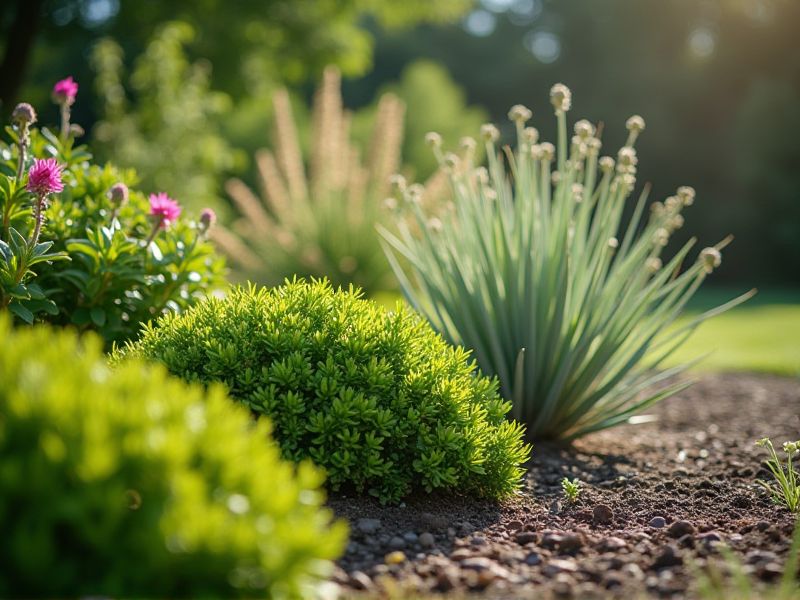
Xeriscape plants are specifically selected for their ability to thrive in arid environments while minimizing water usage. Native species, such as succulents, cacti, and drought-resistant perennials, not only reduce irrigation needs but also enhance soil health and biodiversity. Popular choices include lavender, which attracts pollinators, and ornamental grasses that provide texture and movement in your landscape. By integrating these plants into your garden, you can create a vibrant space that conserves water and requires less maintenance. Implementing xeriscaping principles helps you design an eco-friendly garden that flourishes with minimal resources.
List of some Xeriscape plants that save water
- Lavender (Lavandula)
- Agave (Agave americana)
- Yarrow (Achillea millefolium)
- Russian Sage (Perovskia atriplicifolia)
- Sedum (Sedum species)
- Blue Oat Grass (Helictotrichon sempervirens)
- Red Yucca (Hesperaloe parviflora)
- Penstemon (Penstemon species)
- Lamb's Ear (Stachys byzantina)
- Mexican Feather Grass (Nassella tenuissima)
Important things about Xeriscape plants that save water
Drought-Resistant Species
Xeriscape plants are specifically designed to thrive in arid conditions, making them an excellent choice for water conservation in landscapes. Species such as Agave, Sedum, and Echinacea require minimal watering once established, significantly reducing your garden's water needs. These drought-resistant plants not only enhance the aesthetic appeal of your outdoor spaces but also support local ecosystems by attracting pollinators. By incorporating these resilient species into your landscape design, you can create a sustainable environment that thrives despite limited water resources.
Native Plant Selection
Xeriscape plants, specifically designed for arid environments, thrive with minimal water, making them ideal for sustainable landscaping. Native species such as lavender, sage, and yucca not only withstand drought conditions but also support local wildlife, promoting biodiversity in your garden. These plants have adapted to local climates, utilizing deep root systems and water-conserving features to flourish with reduced irrigation. By incorporating xeriscape plants into your landscape, you ensure a vibrant, eco-friendly garden that minimizes water usage and maintenance needs.
Soil Improvement Techniques
Xeriscape plants are specifically chosen for their ability to thrive in arid environments while minimizing water usage, making them ideal for sustainable landscaping. These drought-resistant species often require minimal irrigation once established, thus promoting efficient water management and reducing overall consumption. Popular xeriscape plants include succulents like agave and various native perennials that flourish in dry conditions, contributing to biodiversity. By incorporating xeriscape plants into your garden, you not only save water but also create a resilient landscape that enhances local ecosystems.
Efficient Watering Practices
Xeriscape plants, characterized by their drought resistance, are essential for sustainable landscaping in arid climates. Incorporating native species like lavender and succulents not only conserves water but also enhances biodiversity in your garden. Utilizing methods such as drip irrigation ensures that water reaches the plant roots directly, minimizing evaporation and runoff. Implementing mulch around these plants can further reduce moisture loss, creating an eco-friendly and low-maintenance landscape.
Grouping Plants By Water Needs
Xeriscape plants are specifically selected for their low water requirements, making them ideal for drought-prone areas. When categorizing these plants, it's essential to consider their varying levels of water needs; some thrive on little moisture while others may require occasional watering. Popular xeriscape choices include native grasses, succulents like agave and aloe, and hardy perennials such as lavender and Russian sage, all of which minimize water usage and promote sustainability. By grouping plants based on their irrigation needs, you can design an efficient landscape that conserves water while maintaining aesthetic appeal.
Mulching Benefits
Mulching around Xeriscape plants significantly improves water retention in the soil, reducing the need for frequent watering. Organic mulches, such as wood chips or shredded bark, decompose over time, enriching the soil and fostering a healthy ecosystem for beneficial microorganisms. This practice also suppresses weed growth, minimizing competition for moisture and nutrients among your water-efficient plants. By implementing an effective mulching strategy, you can enhance the beauty and sustainability of your Xeriscape garden while conserving precious water resources.
Seasonal Maintenance Requirements
Xeriscape plants, designed to thrive in arid climates, require minimal water and are perfect for sustainable landscaping. During the growing season, it's essential to monitor soil moisture levels, ensuring they do not become overly dry, which can stress these drought-tolerant species. Pruning dead or wilted foliage in early spring promotes healthy growth and improves overall aesthetics, while mulching around the base retains moisture and controls weeds. Fall maintenance involves cutting back perennials and assessing plant health to prepare your garden for winter, enhancing the resilience of your Xeriscape landscape.
Designing For Drainage And Runoff
Choosing xeriscape plants can significantly reduce water usage while enhancing your landscape's aesthetic appeal. Native species such as succulents, ornamental grasses, and drought-tolerant perennials are not only visually striking but are also well adapted to local climate conditions, minimizing the need for irrigation. Implementing a well-planned drainage system can further manage runoff, directing excess water away from foundations and preventing erosion. By incorporating these strategies, you can create a sustainable garden that conserves water and supports local biodiversity.
Combining Aesthetics With Functionality
Xeriscape plants are an ideal choice for landscaping, as they are specifically adapted to thrive in arid climates while significantly reducing water consumption. These drought-resistant species, such as succulents, native grasses, and ornamental shrubs, not only enhance your outdoor aesthetics but also promote environmental sustainability. By incorporating vibrant flowering cacti or resilient sagebrush, you can create a visually appealing garden that requires minimal irrigation and maintenance. Choosing xeriscape plants allows you to conserve water resources and cultivate a lush, beautiful landscape that supports local wildlife and promotes soil health.
Long-Term Sustainability And Eco-Friendliness
Xeriscape plants are specifically selected for their ability to thrive in arid conditions, significantly reducing water usage in landscaping. These drought-tolerant species, such as succulents, native grasses, and moisture-retaining groundcovers, provide vibrant aesthetics without the need for excessive irrigation. By incorporating Xeriscape practices, you can create a sustainable garden that conserves water and fosters biodiversity in your local ecosystem. Embracing these eco-friendly solutions not only lowers your water bills but also contributes to long-term environmental health.
